


Gyantse

To Gyantse
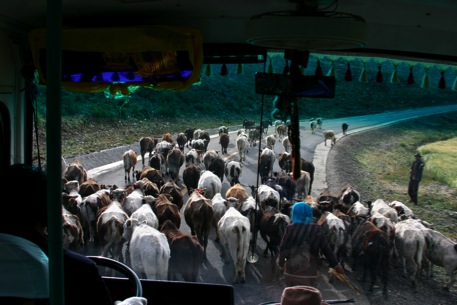 Although the distance to be traveled today is short in principle, it turns out to take a long time to traverse it. The main reason was that the Southern Friendship road was closed. This road would have taken us to Gyantse over a high pass in a matter of hours. No we have to drive back towards Lhasa and take the Northern Friendship Road all the way to Shigatse, and then back to Gyantse. At the end of the day we were looking at the same mountains as in the morning, but now from the other side, after hours and hours of driving.
Although the distance to be traveled today is short in principle, it turns out to take a long time to traverse it. The main reason was that the Southern Friendship road was closed. This road would have taken us to Gyantse over a high pass in a matter of hours. No we have to drive back towards Lhasa and take the Northern Friendship Road all the way to Shigatse, and then back to Gyantse. At the end of the day we were looking at the same mountains as in the morning, but now from the other side, after hours and hours of driving. 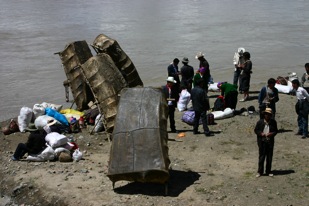
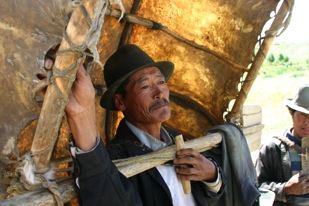
Along the way: boats made out of yak-hide ready to cross the river
31 August – Gyantse
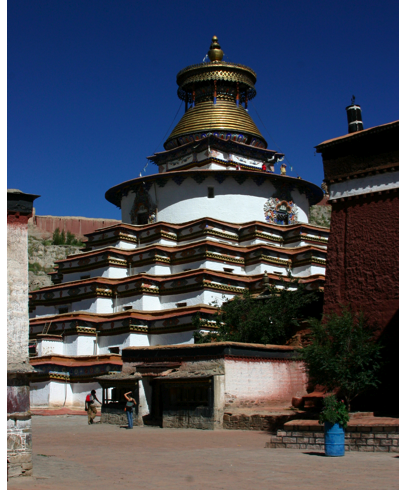 Although Gyantse is supposedly the fourth city of Tibet, it is very small. It has a monastery and a fort on top of a rock. While we declined to climb the latter, the former was a special treat, mainly because of the Gyantse Kumbum. The kumbum is a giant stupa with six stories. You start at the first floor, clockwise as you are supposed to do. The wall is lined with small chapels. In these chapels are murals and a statue of a deity, Buddha or similar. Most of the time it is a wrathful Buddha scaring the unwary! And so it continues, up and up, until finally at level six you reach the eyes of the stupa and have a great view over the valley.
Although Gyantse is supposedly the fourth city of Tibet, it is very small. It has a monastery and a fort on top of a rock. While we declined to climb the latter, the former was a special treat, mainly because of the Gyantse Kumbum. The kumbum is a giant stupa with six stories. You start at the first floor, clockwise as you are supposed to do. The wall is lined with small chapels. In these chapels are murals and a statue of a deity, Buddha or similar. Most of the time it is a wrathful Buddha scaring the unwary! And so it continues, up and up, until finally at level six you reach the eyes of the stupa and have a great view over the valley.It’s amazing to see how each monastery has its own special “flavor” and its little surprises.
The monastery in Gyantse has a spectacular stupa (“Gyantse Kumbum”), which is basically a path spiraling upwards with a chapel every few meters. It’s always a surprise what you’ll find in that chapel – a wrathful Buddha protecting the monastery (one black one was particularly scary) or a “friendly long-ear”?
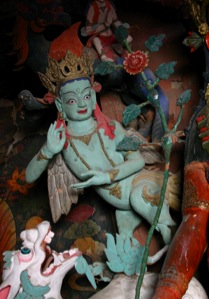
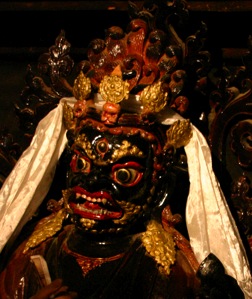
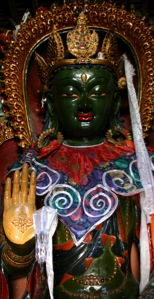
The stupa has six levels, four housing small chapels and the upper two containing one big Buddha for each direction (North, South, etc.).
The design of the Kumbum is influenced by Nepalese art – as is apparent from the four pairs of eyes painted onto the level below the golden roof, one glancing in each cardinal direction. It reminds us of the big stupa in Kathmandu!
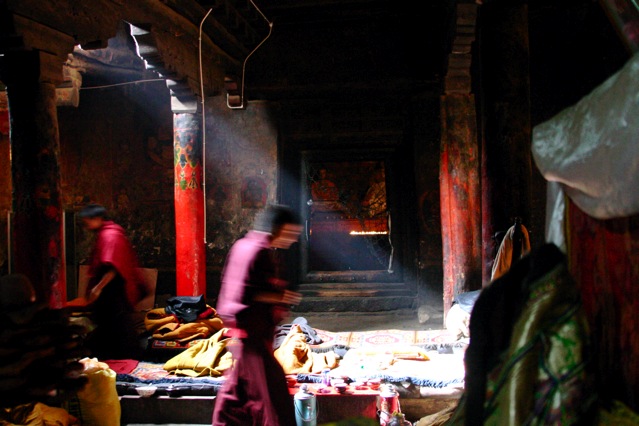
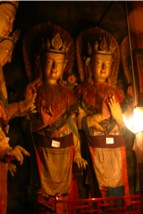 On the first half of our trip to Kathmandu we visited multiple monasteries, and I didn’t tire of them. The mixture of the primitive, mundane life ( big pots of yak butter tea everywhere, the necessity to sweep, wash, keep the candles burning, the stone buildings, dusty monks’ robes, haphazard pairs of shoes tossed on piles in front of the prayer halls, from flip flops to tevas and moccasins) – the mystic and irrational (dark chapels with intimidating Buddha statues, lit only by lakes of yak butter candles and small gap-windows high above, the worn prayer robes and pillows, the monotonous chants and music) – the academic, rational atmosphere (the debates, libraries, scholarly life) – this mixture continues to fascinate me. Buddhist monasteries strike me as a mélange of monastery, boarding school, trading post, and university. It’s necessary to have a part of society devoted to thinking for thought’s sake. The academic life is channelling human curiosity, elevating it from a basic drive to the systematic approach of scientific research. The nature of Buddhist debates shows that repetition of doctrines and conservation of traditions aren’t the sole purpose of a monastery. (Probably the same is true for any serious “faith” or philosophy.)
On the first half of our trip to Kathmandu we visited multiple monasteries, and I didn’t tire of them. The mixture of the primitive, mundane life ( big pots of yak butter tea everywhere, the necessity to sweep, wash, keep the candles burning, the stone buildings, dusty monks’ robes, haphazard pairs of shoes tossed on piles in front of the prayer halls, from flip flops to tevas and moccasins) – the mystic and irrational (dark chapels with intimidating Buddha statues, lit only by lakes of yak butter candles and small gap-windows high above, the worn prayer robes and pillows, the monotonous chants and music) – the academic, rational atmosphere (the debates, libraries, scholarly life) – this mixture continues to fascinate me. Buddhist monasteries strike me as a mélange of monastery, boarding school, trading post, and university. It’s necessary to have a part of society devoted to thinking for thought’s sake. The academic life is channelling human curiosity, elevating it from a basic drive to the systematic approach of scientific research. The nature of Buddhist debates shows that repetition of doctrines and conservation of traditions aren’t the sole purpose of a monastery. (Probably the same is true for any serious “faith” or philosophy.)We observed a studying session of elder monks who read in carbon copied sheets made by one monk in the same room with the help of complicated machinery. The scene was very reminiscent of a bundle of geeks hunched over their laptops, especially because the sheets were black with white letters.
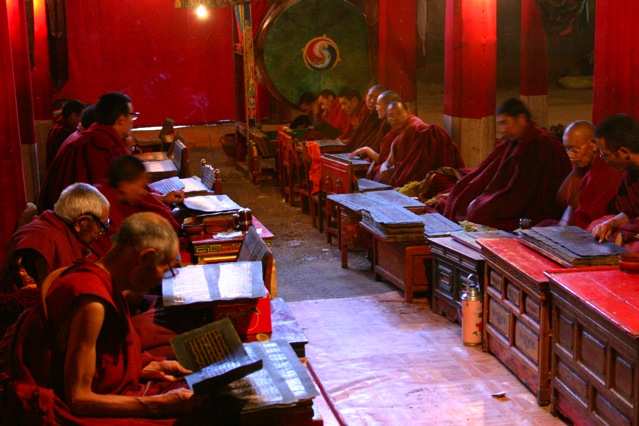
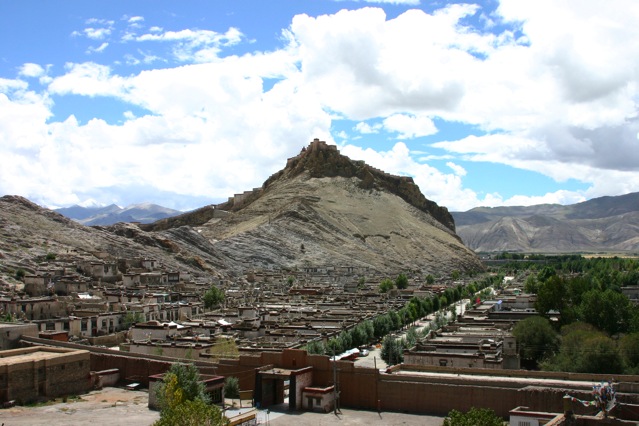 The “Dzong” of fort viewed from the Kumbum
The “Dzong” of fort viewed from the Kumbum

